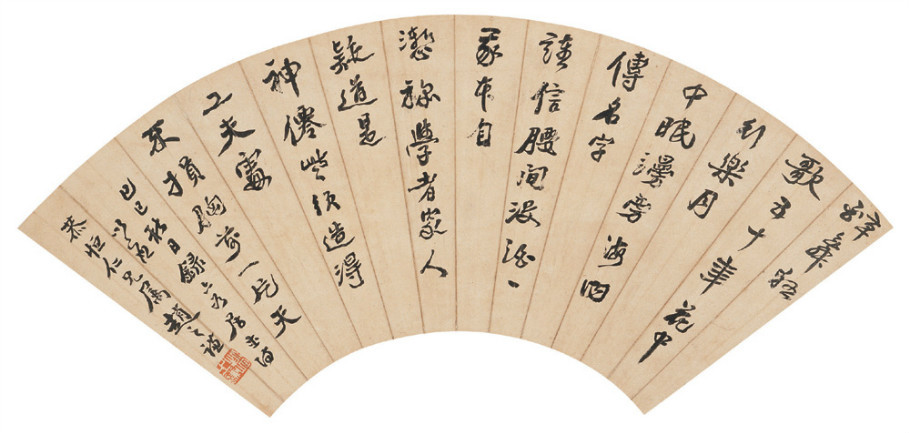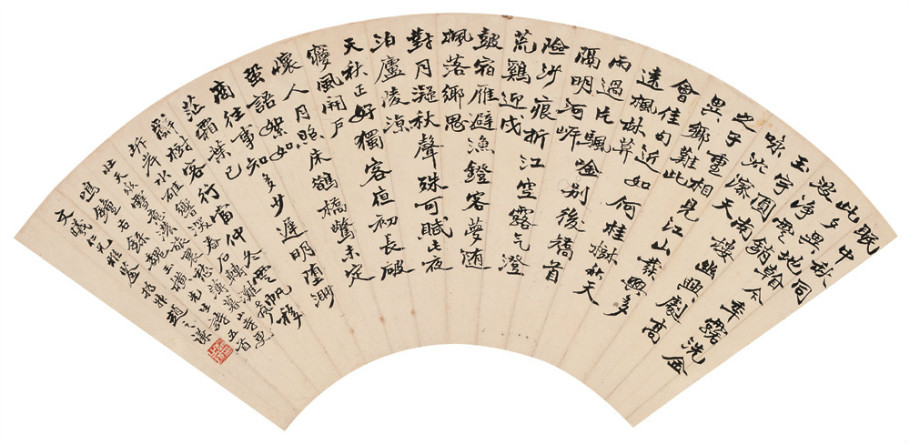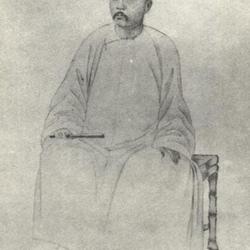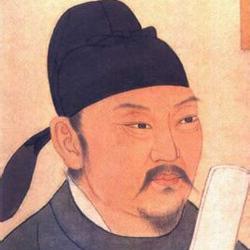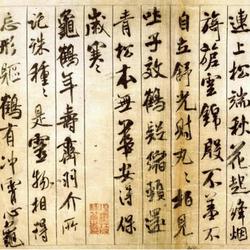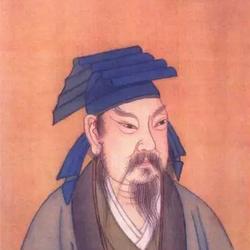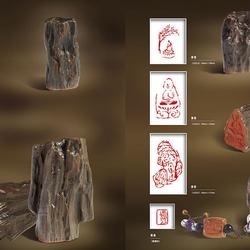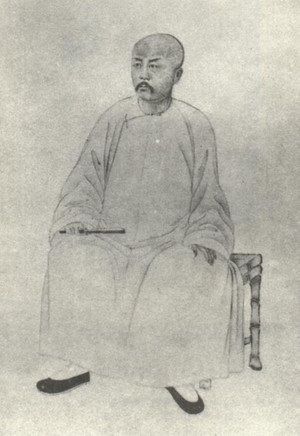
Zhao Zhiqian (1829-1884) was born in Shaoxing, Zhejiang. The first name was Yifu, and the nickname was Lengjun; later the name was changed to Lushu, and the names were Beian, Mei'an, Wumen, etc. In his youth, he became famous all over the world for his talent. He was an outstanding calligrapher, painter and seal carver in the Qing Dynasty. His seal cutting was based on the epigraphic characters of the Qin and Han Dynasties, and he took the essence and used macros to form his own style, which is known as the "Zhao School". His attainments in calligraphy are multi-faceted, and he can integrate Zhen, Cao, Li and Zhuan brushwork into one, complementing each other and contrasting each other. Zhao Zhiqian once said: "Independence is precious, the world is huge, many people say it, and independence is hard to find." He made unremitting efforts in poetry, calligraphy, painting and art throughout his life, and finally became a master of his generation.
Zhao Zhiqian was proficient in calligraphy, painting, and seal cutting. His calligraphy style belonged to that of Deng Wanbai, Bao Shenbo, and Wu Rang. He learned from Bao's writing method of Beibei. His seal script has its own unique light. His talent is unique and he can carry it forward, so he produces works with a very modern flavor. In this regard, he himself was somewhat reserved, but people at the time failed to fully understand him. Although sometimes there is some ink bleeding in his seal and official works, the wonderful feeling expressed by his sharp brushstrokes cannot but be admired.
Under the influence of Bao Shichen and others' calligraphy theory of "advocating stele and suppressing calligraphy", a great genius emerged in the Qing Dynasty - Zhao Zhiqian, who dabbled in various calligraphy styles and left numerous excellent works. Taking cursive writing as an example, we can see a kind of perseverance and forcefulness that is different from traditional cursive writing. Cursive script is more likely to arouse emotional excitement, but Zhao Zhiqian is able to integrate the solemnity of seal script, official script, regular script and other calligraphy styles into this elegant and free cursive script, in which we can still get a glimpse of Zhao's own inner emotions and spirit.
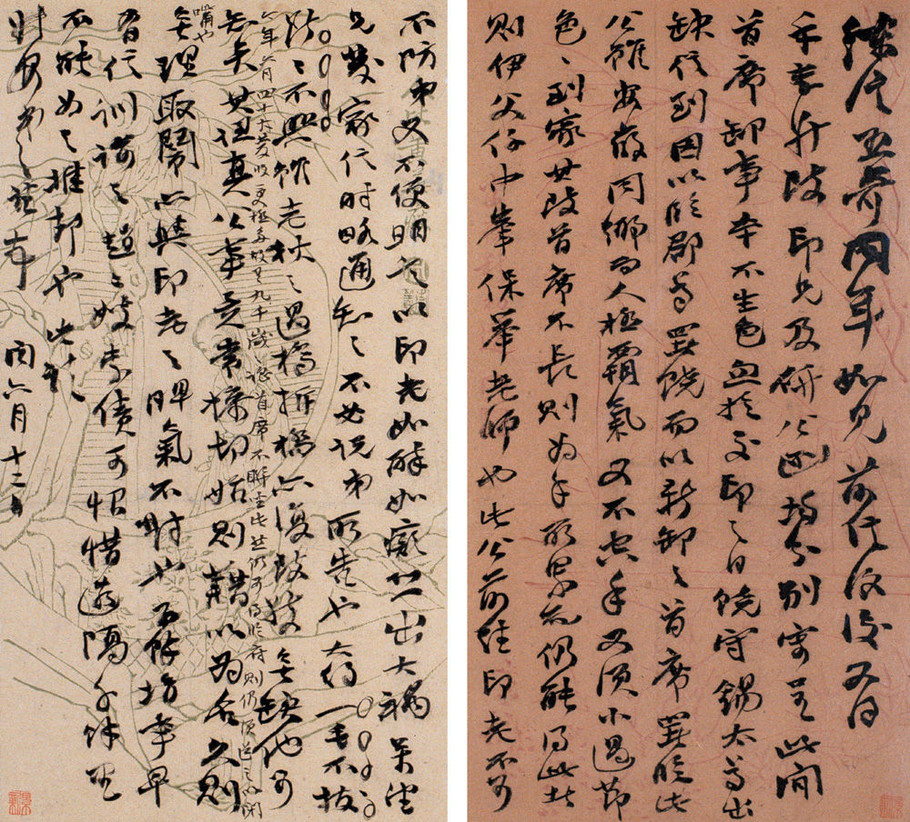
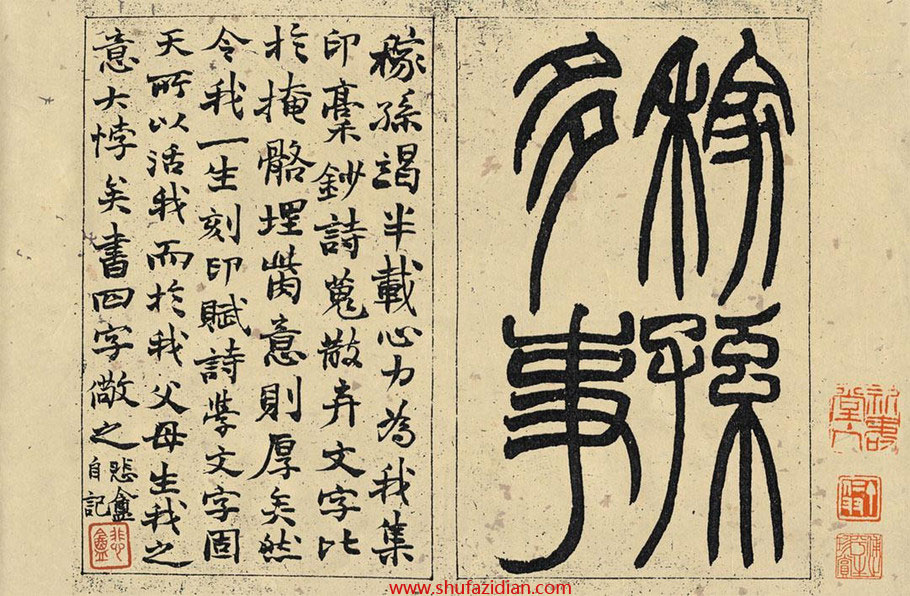
Zhao Zhiqian's inscription on the seal

A portrait of the mountain, seal script, mirror heart, 1870

"Shihengshui Divides" in running script, Jingxin, paper
This five-character painting in regular script comes from the poem "Looking across the Lake from Nanshan to the North" by Xie Lingyun of the Song Dynasty in the Southern Dynasty: "The water flows across the stone, and the forest is dense and there are no traces." It is written in the style of Wei stele. The knot of this book is strict and dignified. The brush strokes are vigorous and vigorous, and the ink color is as thick as paint. Although it is based on the Fabei stele, it still retains the charm of the word Yan. It is the standard "Yan Di Wei Noodle". This calligraphy is strict but not rigid. You can see the danger in the flatness and the warmth in the square folds. For example, the character "horizontal" has dense knots, but the beginning of the "wood" part is long and powerful. Another example is the long horizontal line in the middle of the character "Liu", which is strong and powerful. The rising and closing of the strokes are satisfying and show great energy. This book pays attention to the avoidance of unevenness and the contrast of density and density, all of which are natural and charming.
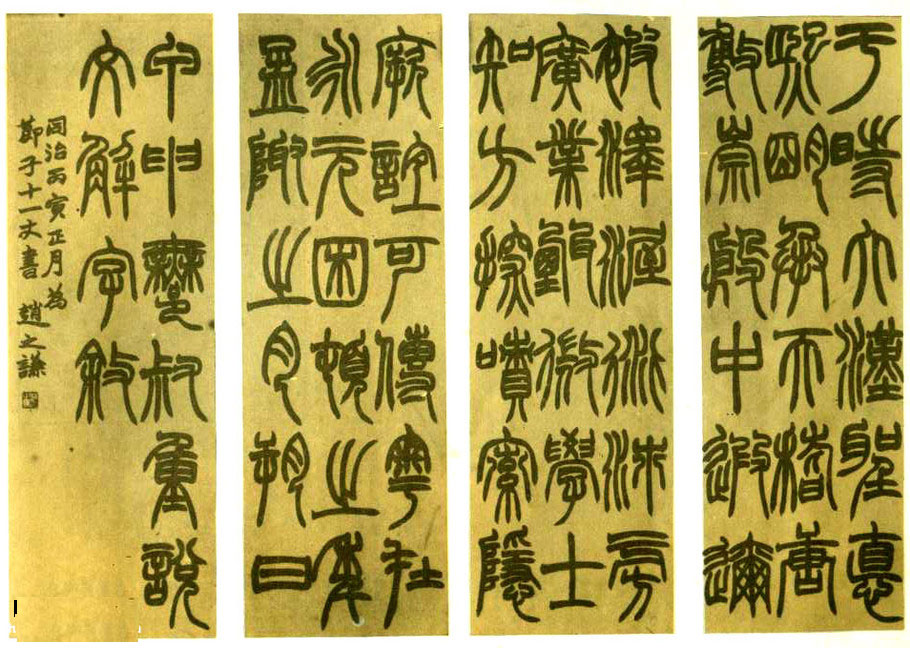
Seal script four screens
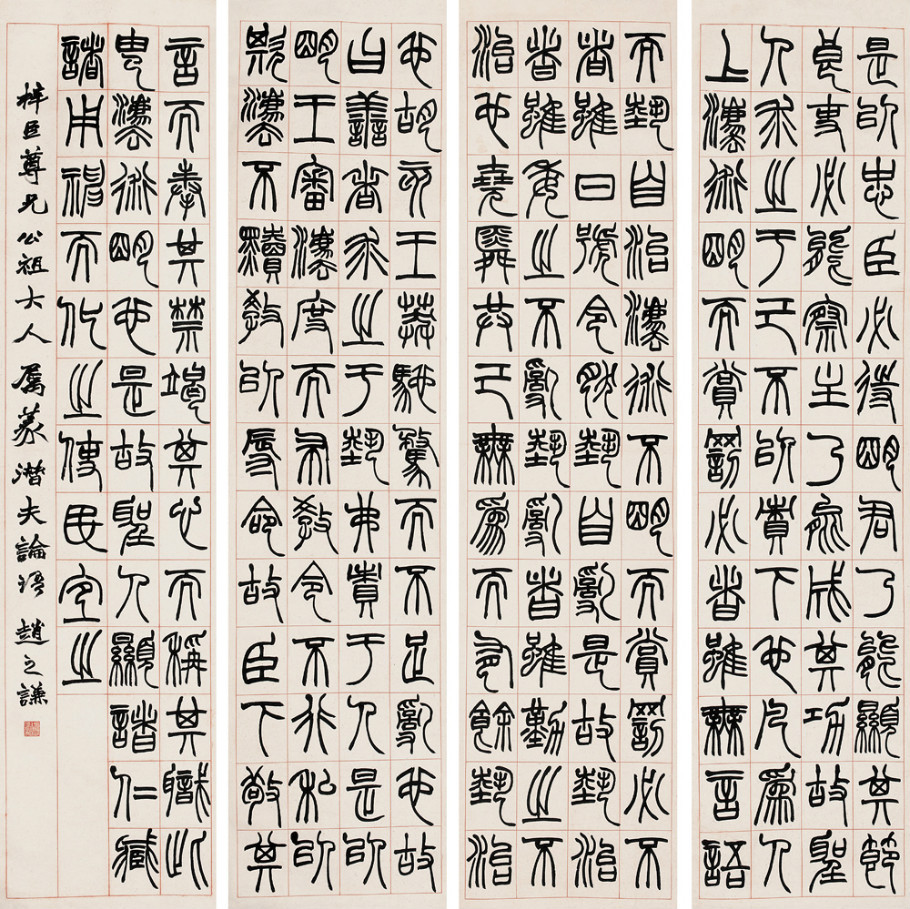
Seal script four screens
Seen in the 2005 Spring Auction of China Guardian International Auction Co., Ltd. Special sale of ancient Chinese calligraphy and painting
Size: 246.5×59cm×4
Introduction: Seal: Zhao Zhiqian’s seal of longevity in Kuaiji
Title: Zi Chen respects his elder brother, Gongzu, and belongs to the Analects of Seal and Qianfu. Zhao Zhiqian.
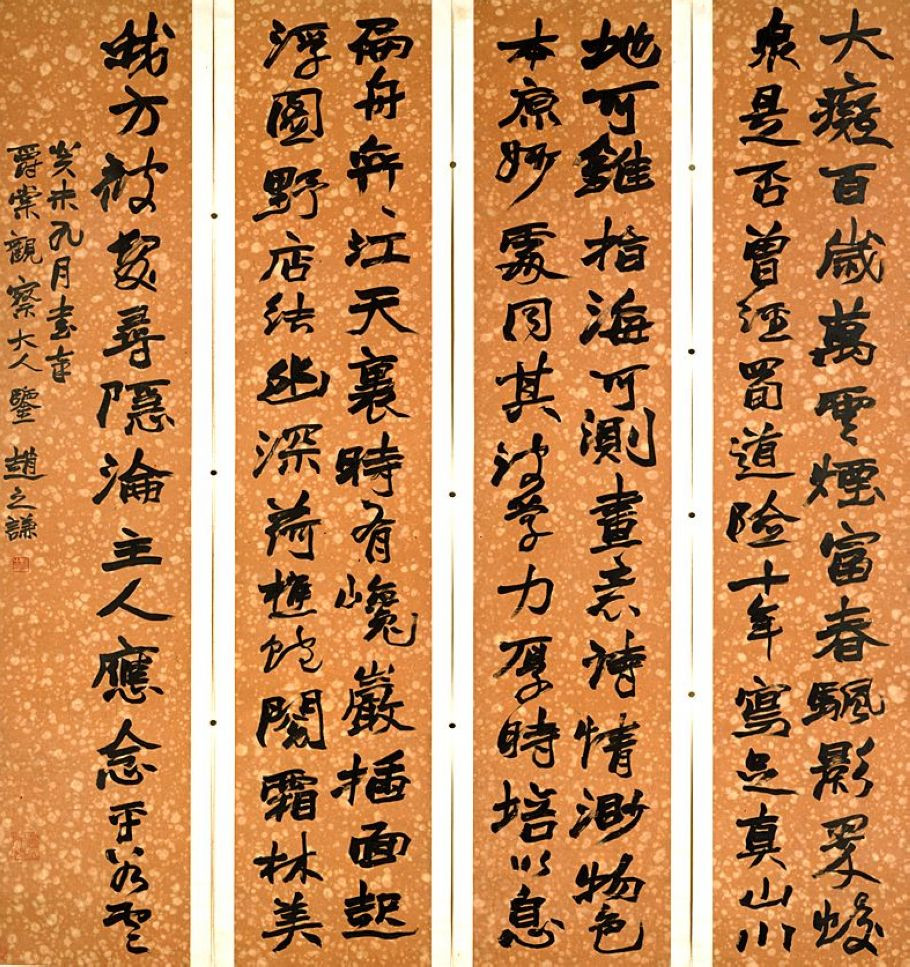
Zhao Zhiqian's "Four Screens of Seven-Character Ancient Poems in Running Script" Tiger-spotted Paper, 166.0cm long and 34.0cm wide each
Collection of Tokyo National Museum, Japan (gift from Takashima Kikujiro)
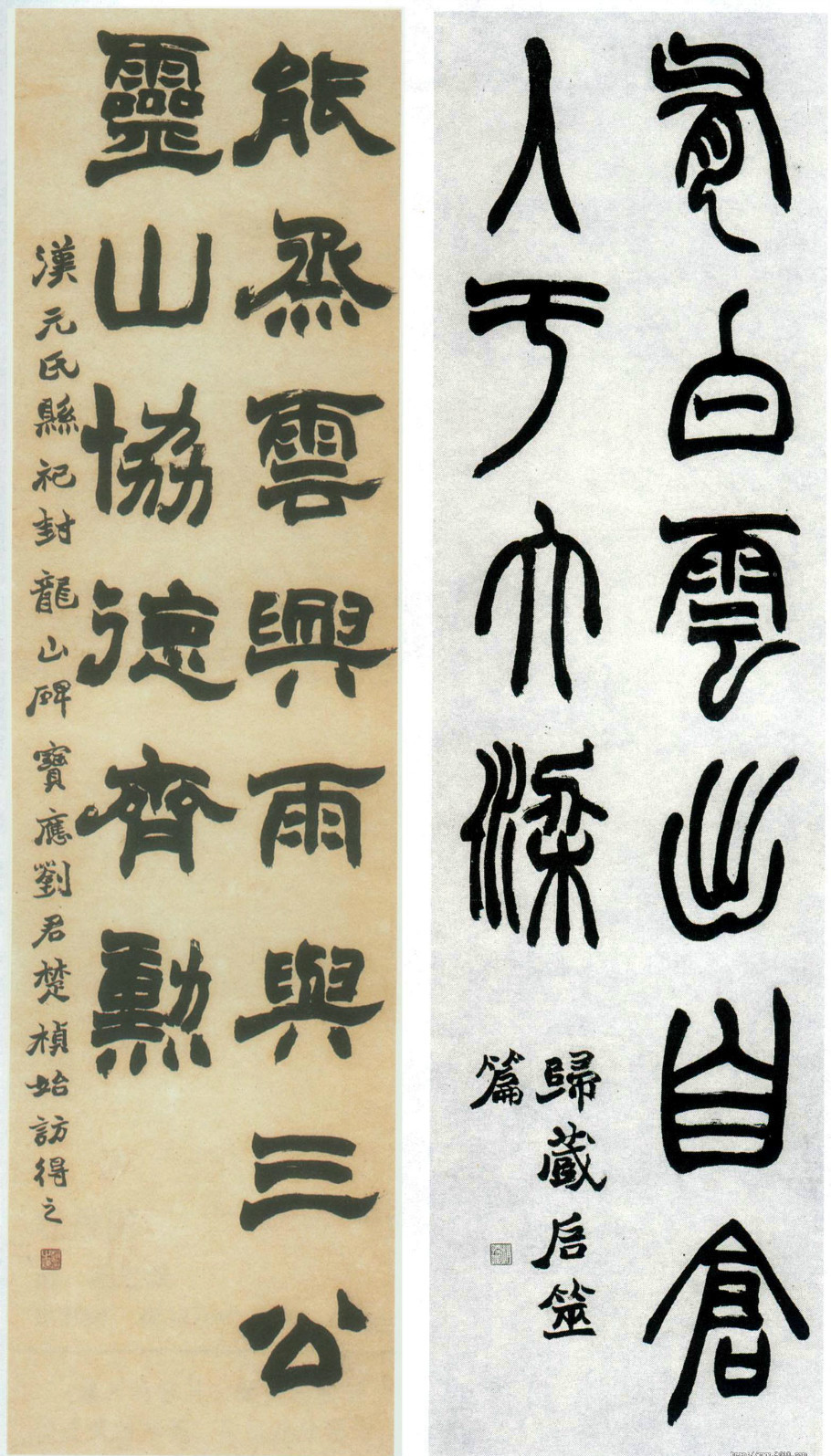
Four lines of ancient sayings on paper 01
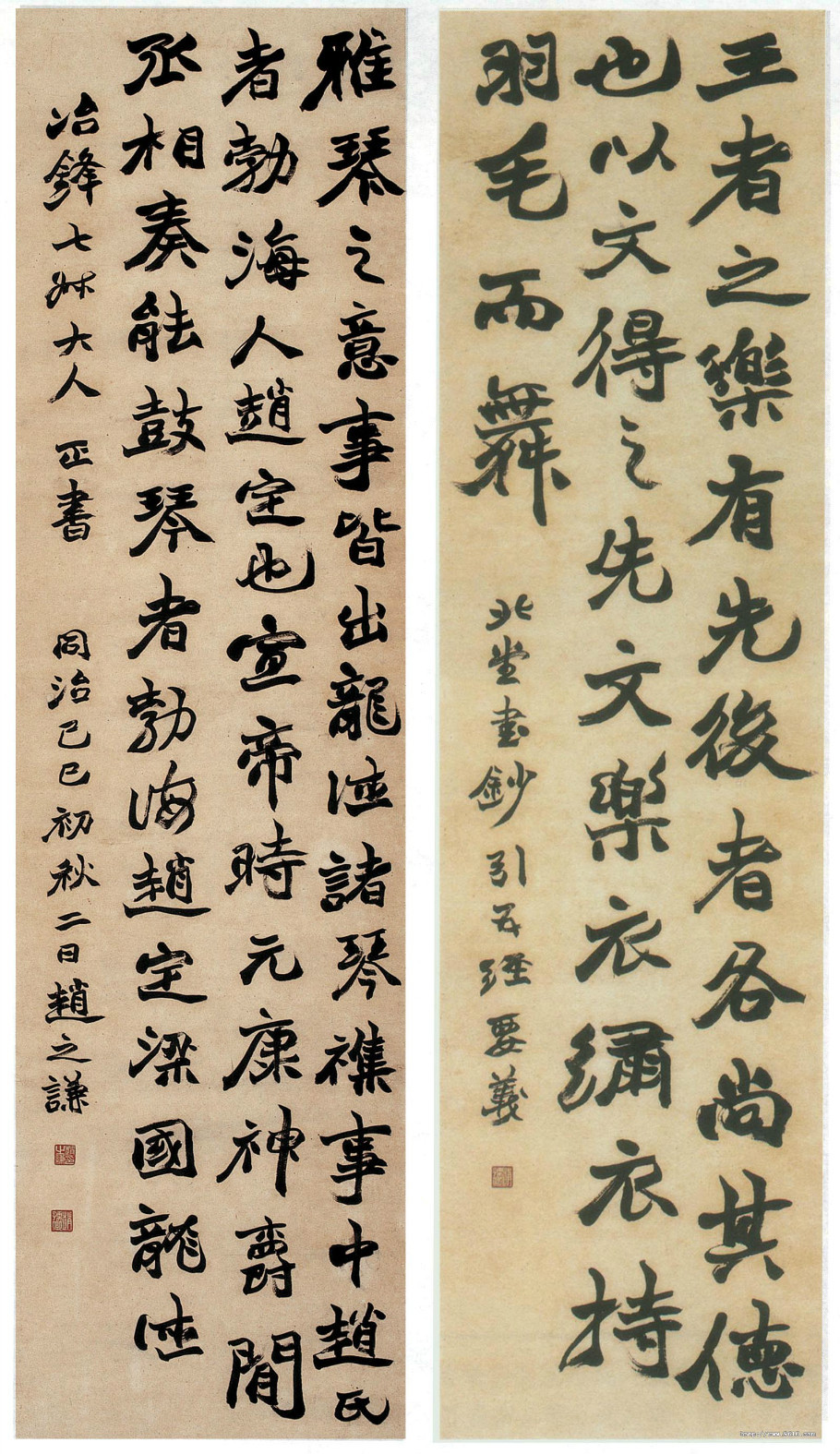
Four lines of ancient sayings on paper 02
Four-striped paper version of calligraphy and ancient sayings, 165X44cmX4, collected by Xiling Seal Society
The information comes from "Xiling Seal Society's Centenary Collection of Excellent Works" (Xiling Seal Society Publishing House)

"Ode to the Heart in Regular Script" scroll, collected by the Palace Museum in Beijing, on Gaoli paper, 128.5cm in length and 36cm in width.
This scroll in regular script records the text "Ode to the Heart" written by the monk Zhiguo in the Sui Dynasty. There are 6 lines in total and 22 characters in the whole line. The last inscription is: "The record of Zhao Zhiqian in the fifth month of Yichou in Tongzhi." At the bottom are "Zhao Zhiqian's seal" and "Han There was this person before the later Sui Dynasty." Seal two directions. In the lower left corner is a collection seal of "Master's Collection". On the edge of the frame is a line of inscription "Master Shou Jade", which reads "Master Shou Jade Seal". This scroll was written by Zhao Zhiqian at the request of his friend "Gan Bo". It was Yichou, the fourth year of Tongzhi (1865), when Zhao was 37 years old.
The calligraphy on this axis is tall and straight, with clear edges and corners. The characteristics of Wei stele calligraphy are very obvious. It represents the calligraphy style of Zhao Zhiqian's patriarchal Beibei calligraphy in the early period. It is a refined work of Zhao's early calligraphy and an outstanding example of Beibei calligraphy in the late Qing Dynasty. work. The writing in this book is square and neat, and still retains the charm of the official script. It uses side edges at the beginning of the writing, showing its sharp edge, which is very distinctive.
The text recorded on this scroll is an important calligraphy treatise written by Zhiguo, a monk from Yongxing Temple in the Sui Dynasty. Zhiguo is good at official, running and cursive scripts, and wrote his experience in the article "Ode to the Heart" to show the method of writing calligraphy. This article was later annotated by Yao Peizhong of the Qing Dynasty and became popular at that time.
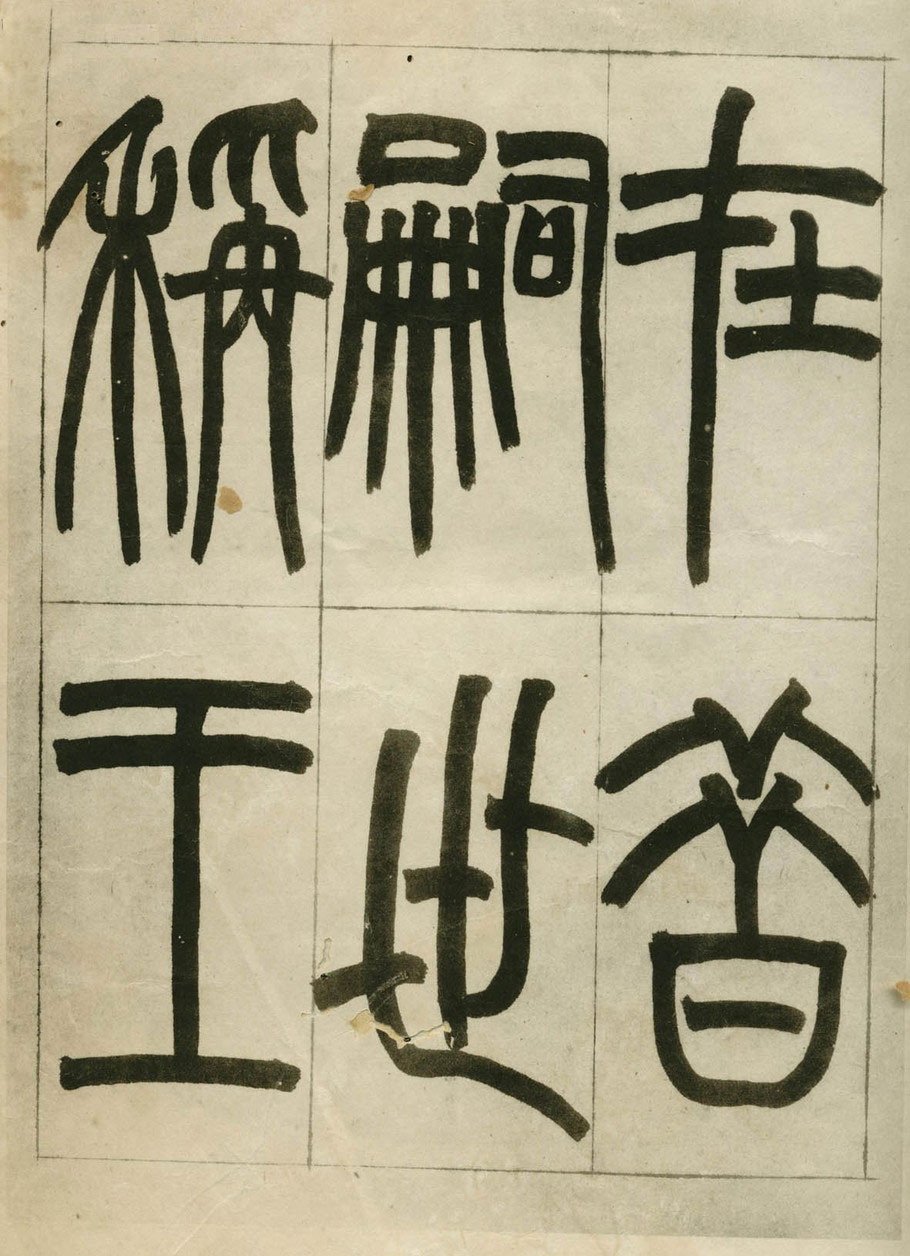
Zhao Zhiqian "Linyi Mountain Carved Stones" on paper
The Qin Dynasty's "Yishan Carved Stones" has a long history. The original stone was lost during the Northern Wei Dynasty, and many subsequent generations have reprinted it. Today's people can no longer glimpse its charm and charm. Zhao Zhiqian's copy basically used his own calligraphy to interpret the stele, and became an excellent model for future generations to learn seal script.
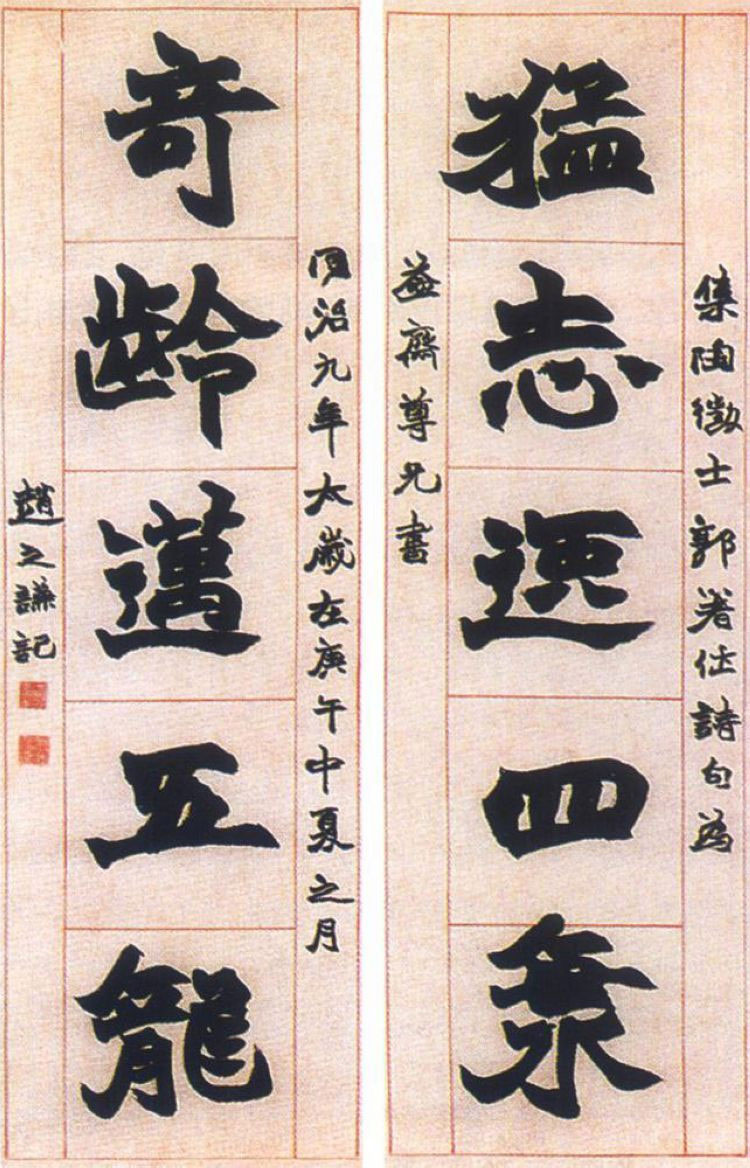
Zhao Zhiqian's "Five Character Couplets in Official Script" is collected by the Palace Museum.
The brush strokes of this work are pure, the atmosphere is open, the blood (breath) is smooth, and the expression is dazzling. It can be said to be free and powerful. The freedom of expression means that Zhao Zhiqian's pen can be lifted, laid down, and collected; Fang Junqiu's vigorous calligraphy means that Zhao Zhiqian's calligraphy has the foundation of Beibei, using Beibei as its material and Wanbaishan people as its text. This work is in line with its law, body and spirit.
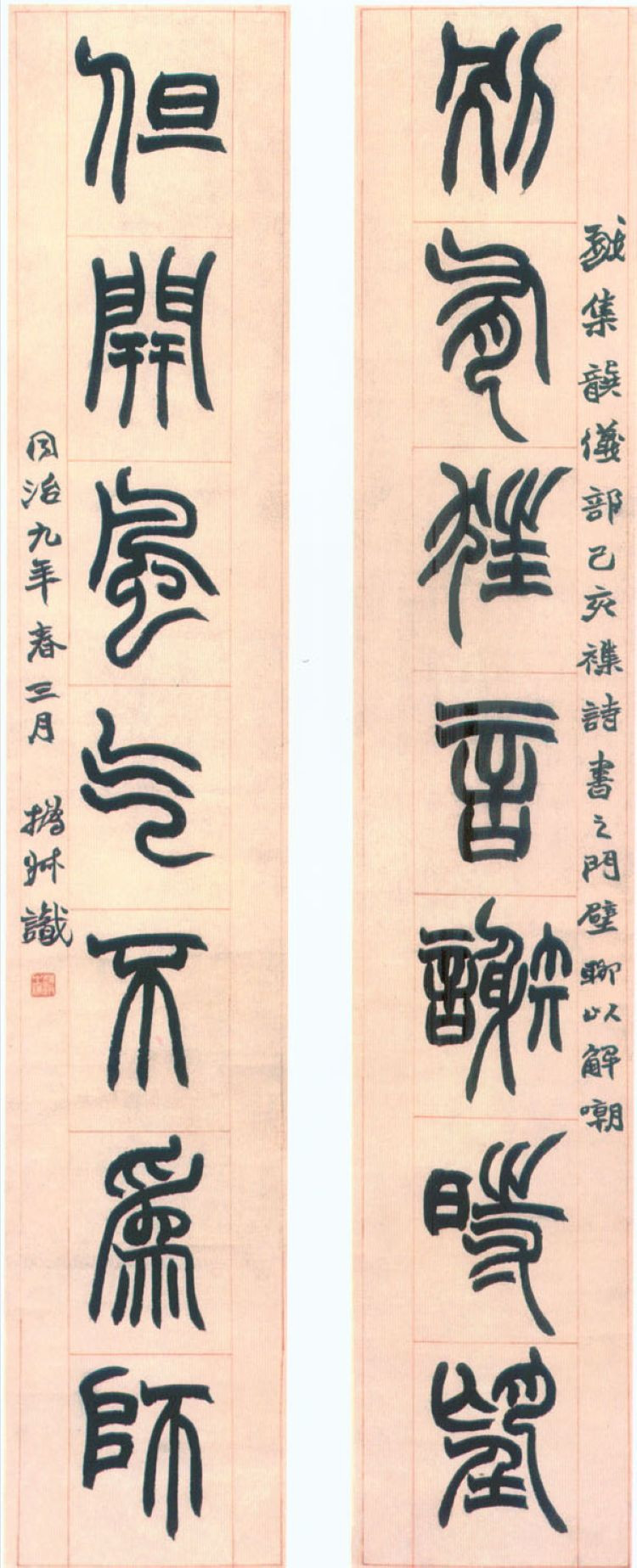
Seven-Character Couplet of Gong Yibu's Poetry in Seal Script
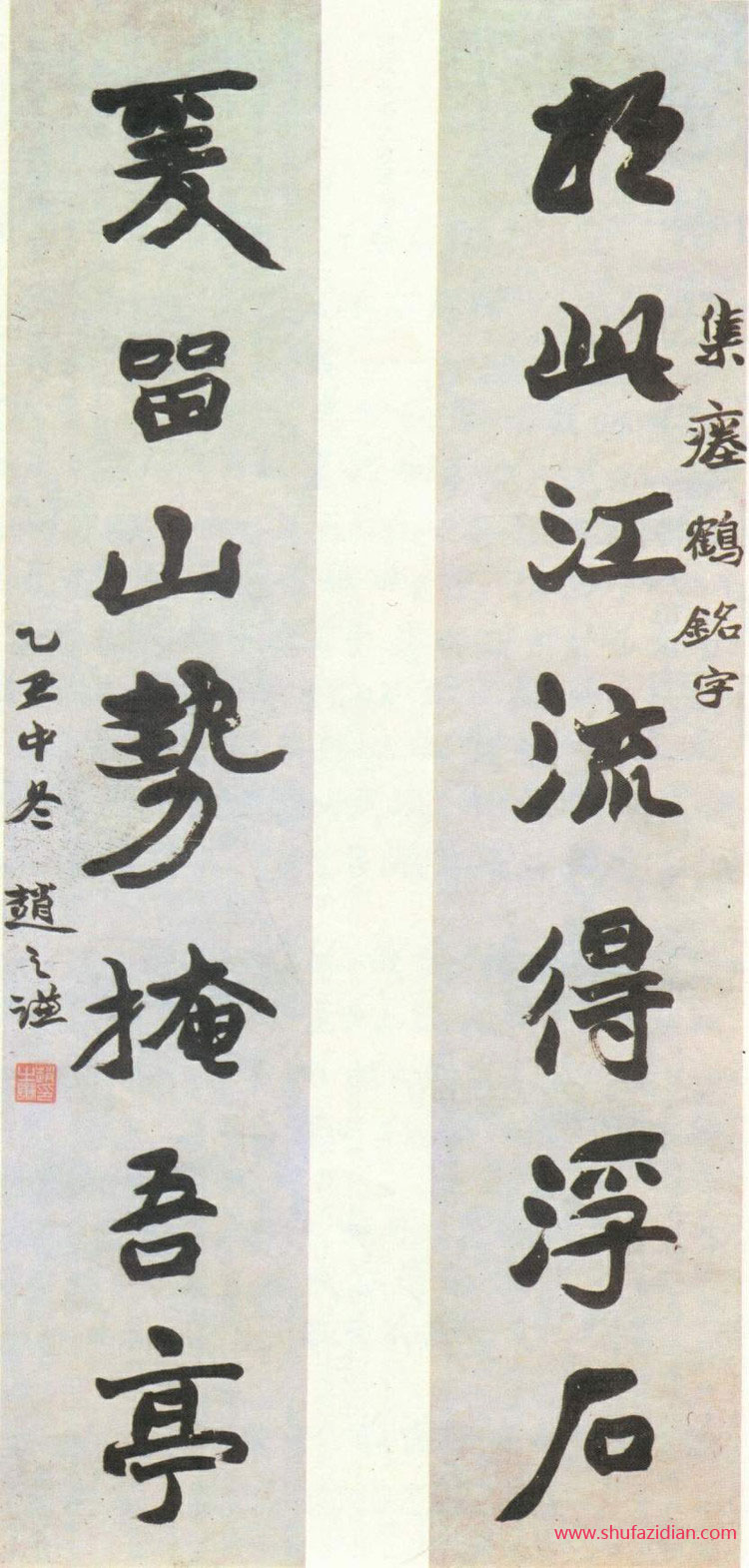
Zhao Zhiqian, regular script collection (yì), seven-character couplet with crane inscription, paper
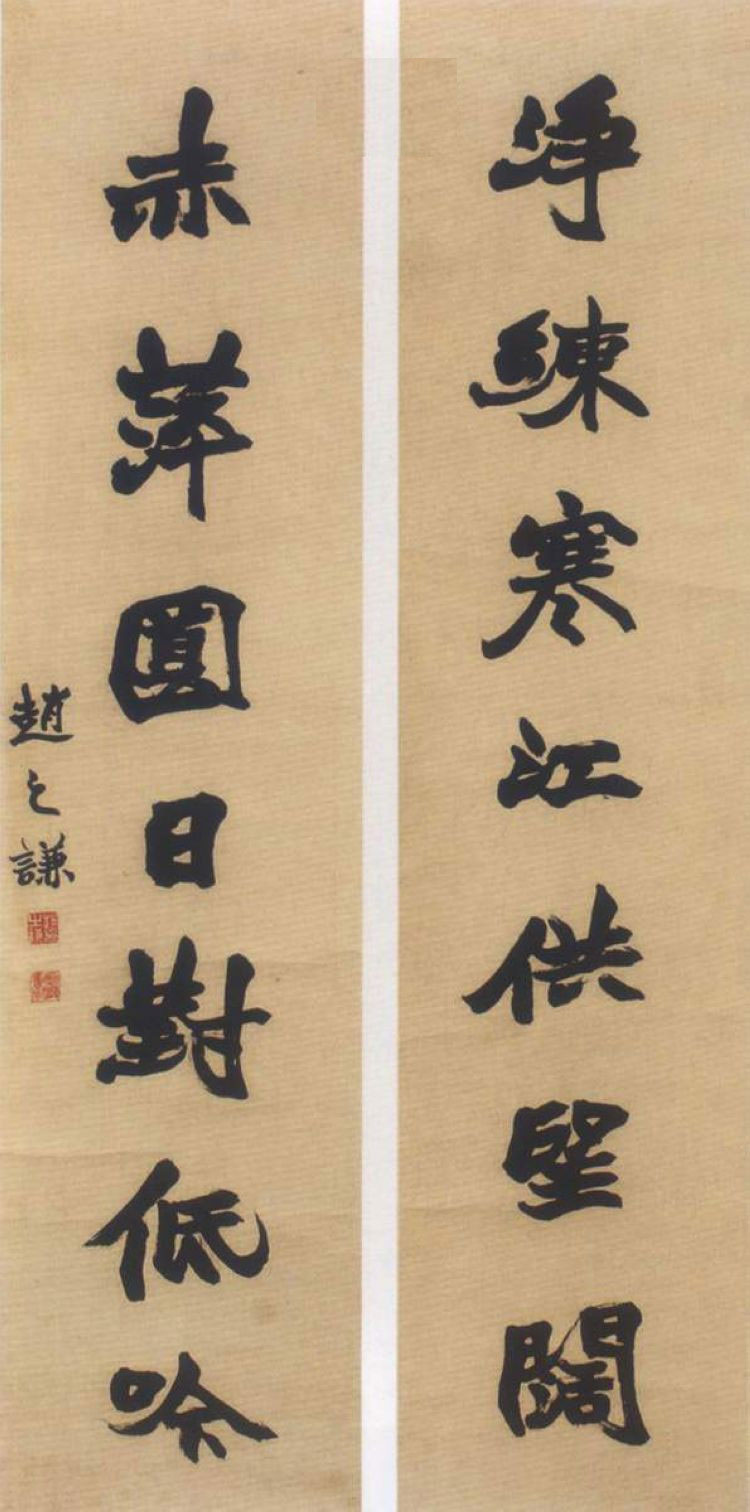
Zhao Zhiqian's "Seven Character Couplets in Official Script" on paper, vertical scroll 136×32cm×2
This couplet "Purely practice the cold river to look out at the broad sky, and the red duckweed is singing softly against the round sun." The writing style is thick and smooth, and the strokes are coherent. The meaning of the writing is connected with each other, and the emotions are related to each other. Judging from the arrangement of each row, the whole work is full of bones and flesh, and uses the majestic and majestic north stele to emphasize the shape. It becomes more and more wonderful day by day. It is Zhao Weng's masterpiece.
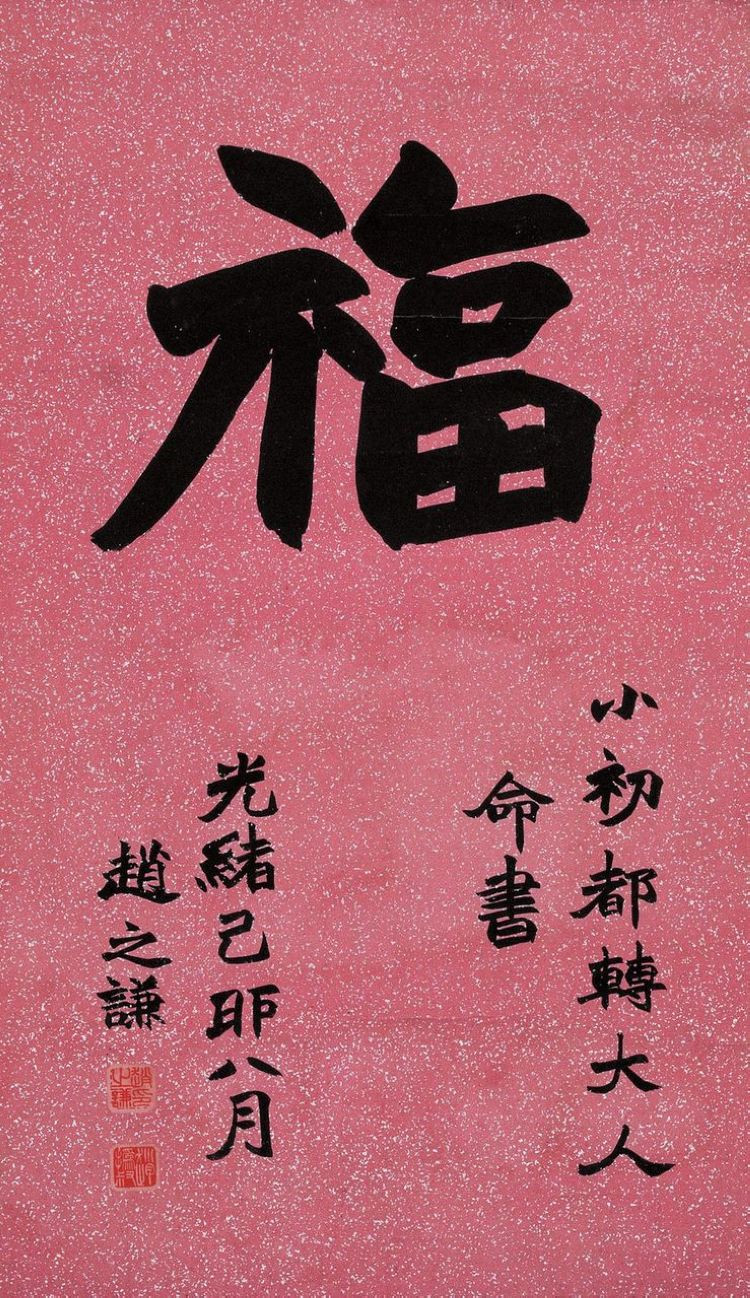
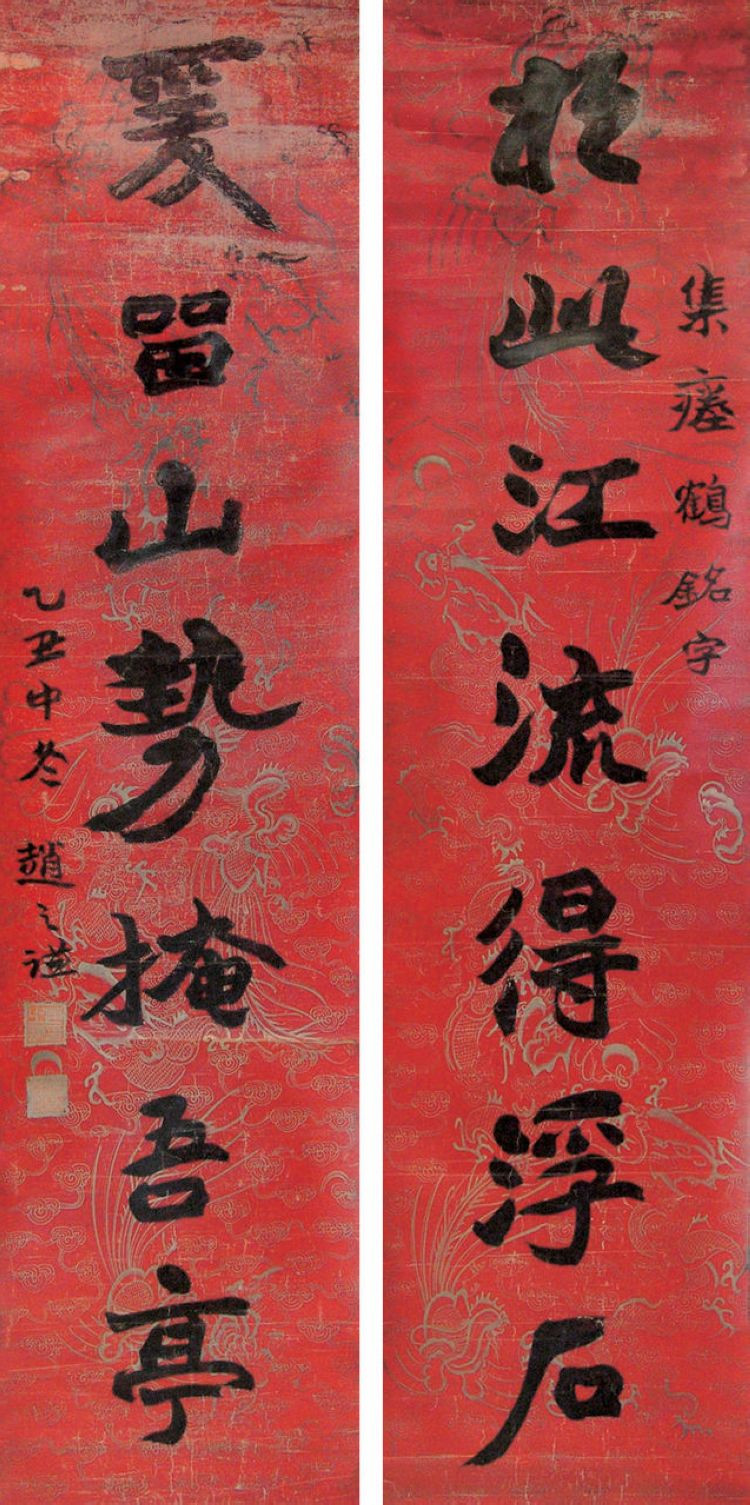
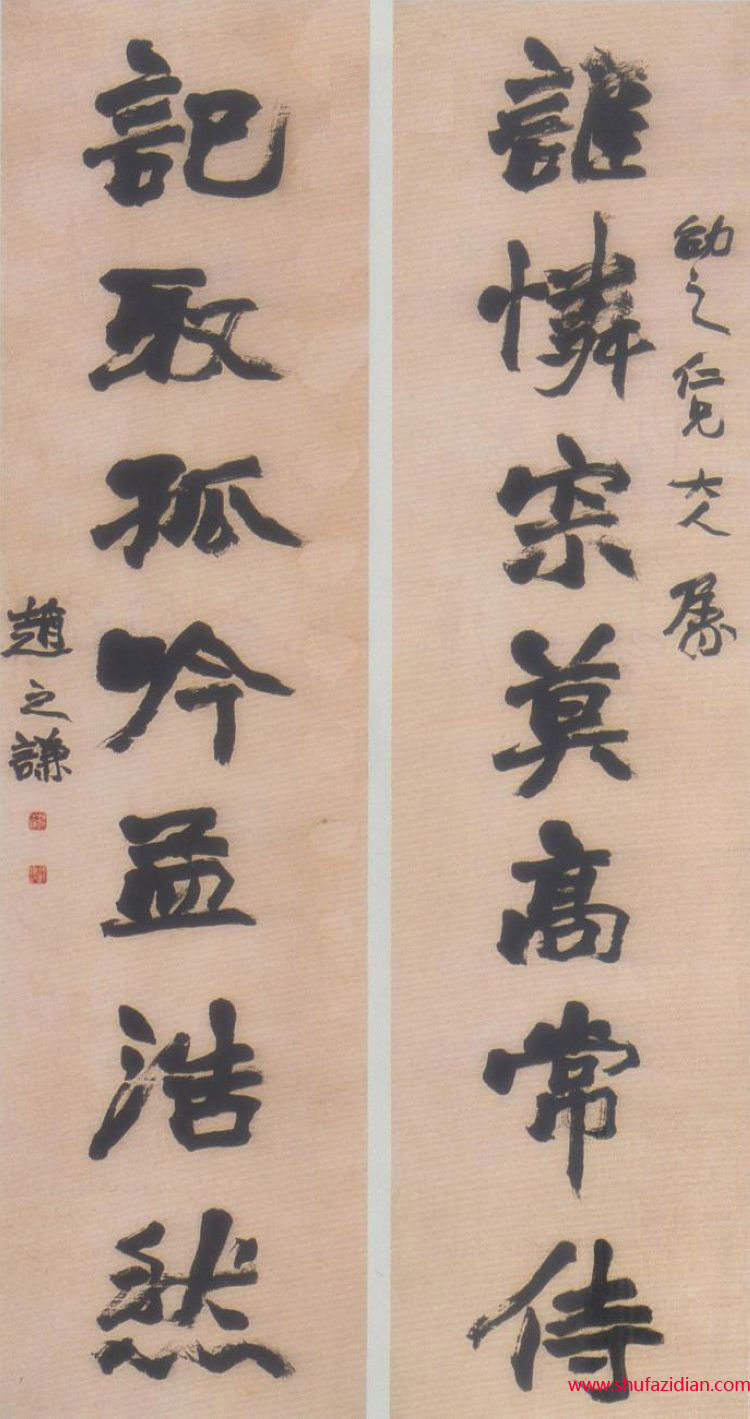
Zhao Zhiqian's "Seven Character Couplet"
This lively and strange but not dull official script couplet was written by Zhao Zhiqian. Zhao Zhiqian not only vividly displayed the characteristics of his brushwork excavated from Bei Stele in regular script and running script, but also applied this unique brushwork to his seal script and official script. From this work This feature can be seen. The sharp square carvings of the calligraphy stipples and the overlapping strokes at the turning points make the stipple work full of power and full of three-dimensionality. The glyph structure takes the momentum from the side, and the center of gravity stretches from the lower left corner to the upper right, achieving balance in unity. He is also good at using the decisiveness and rapid rhythm changes of his strokes to fully embody the sense of power and movement. Therefore, his calligraphy looks lively and strange rather than rigid.
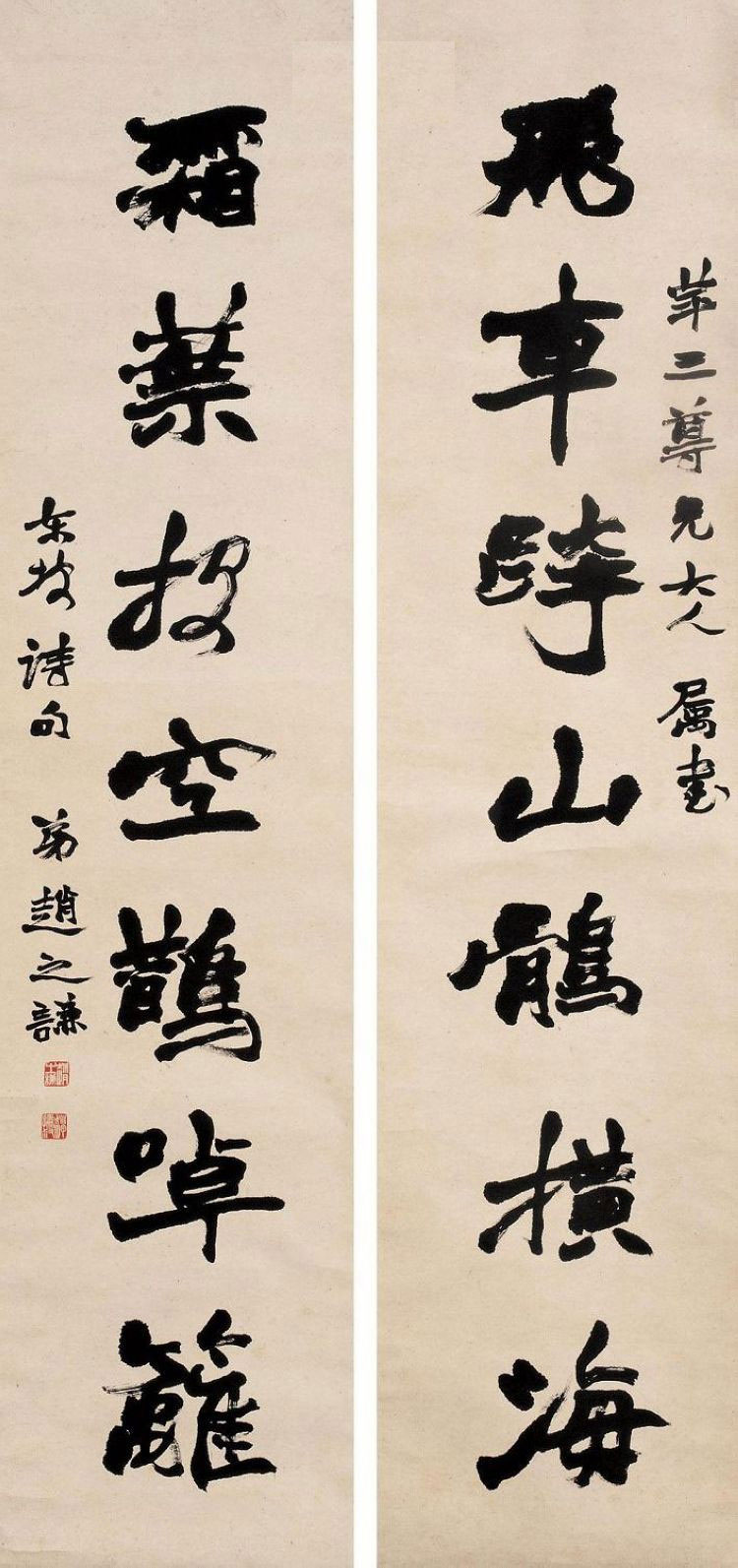
Zhao Zhiqian's "Seven Character Couplet in Running Script", vertical scroll, paper, 133×30.5 cm×2
Seal: Zhao Zhiqian, Uncle Ruo
Note: Mr. Ping San Zunxiong’s poems are written by Dongpo. His younger brother Zhao Zhiqian.
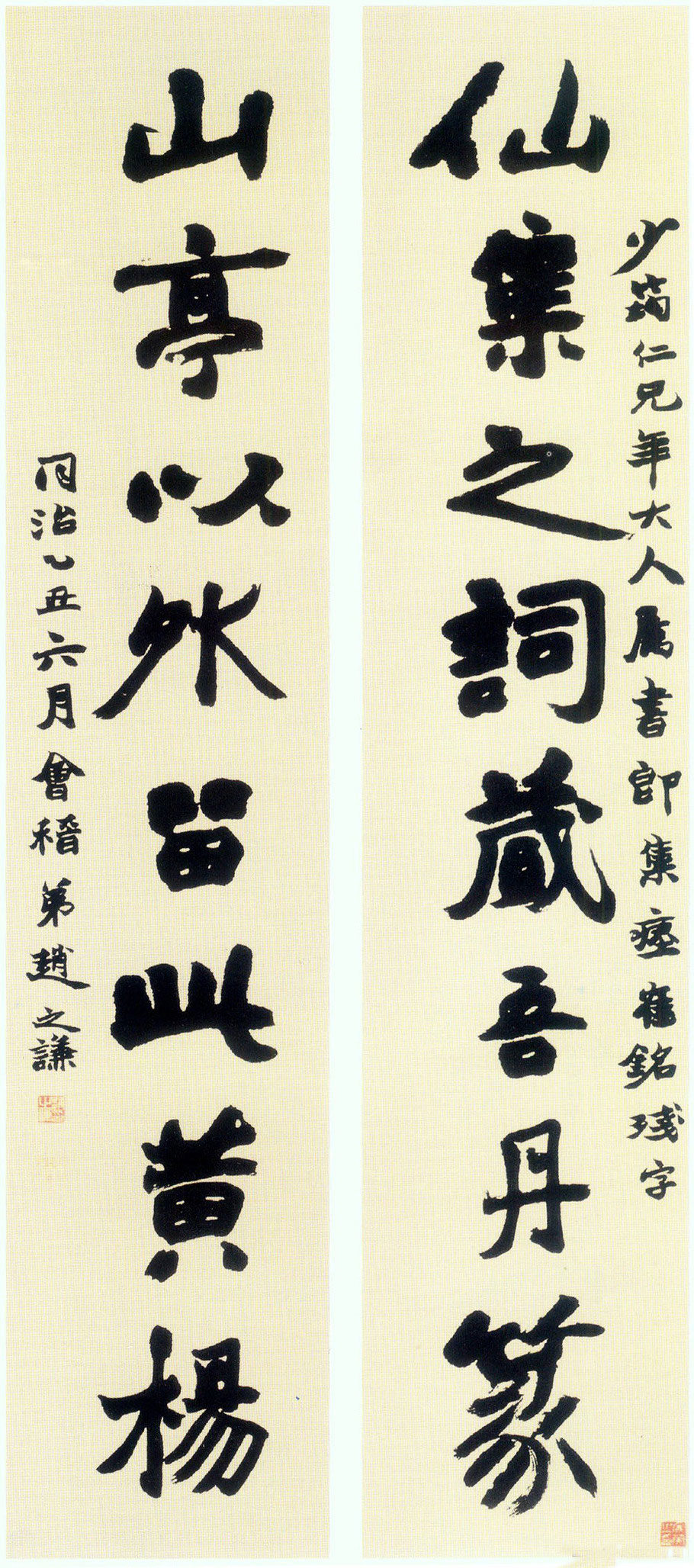
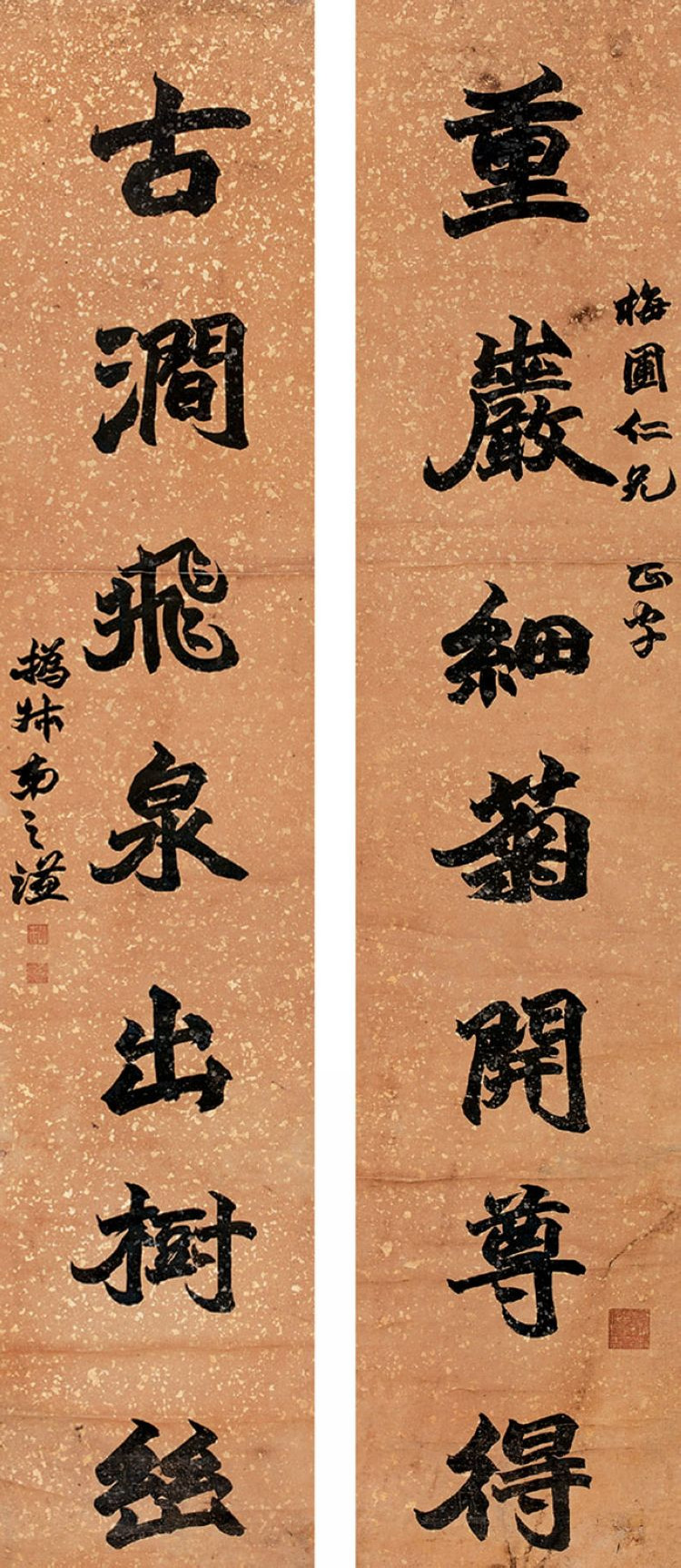
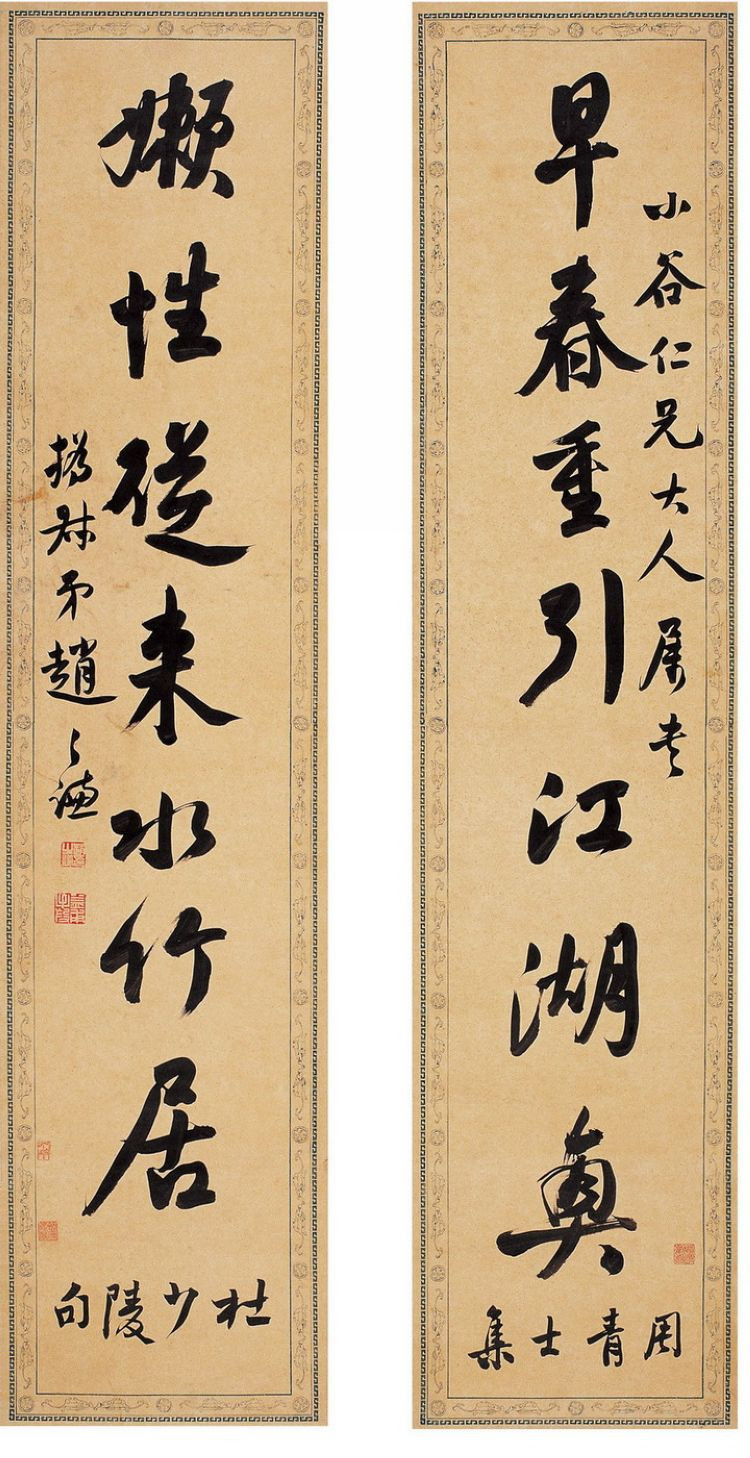
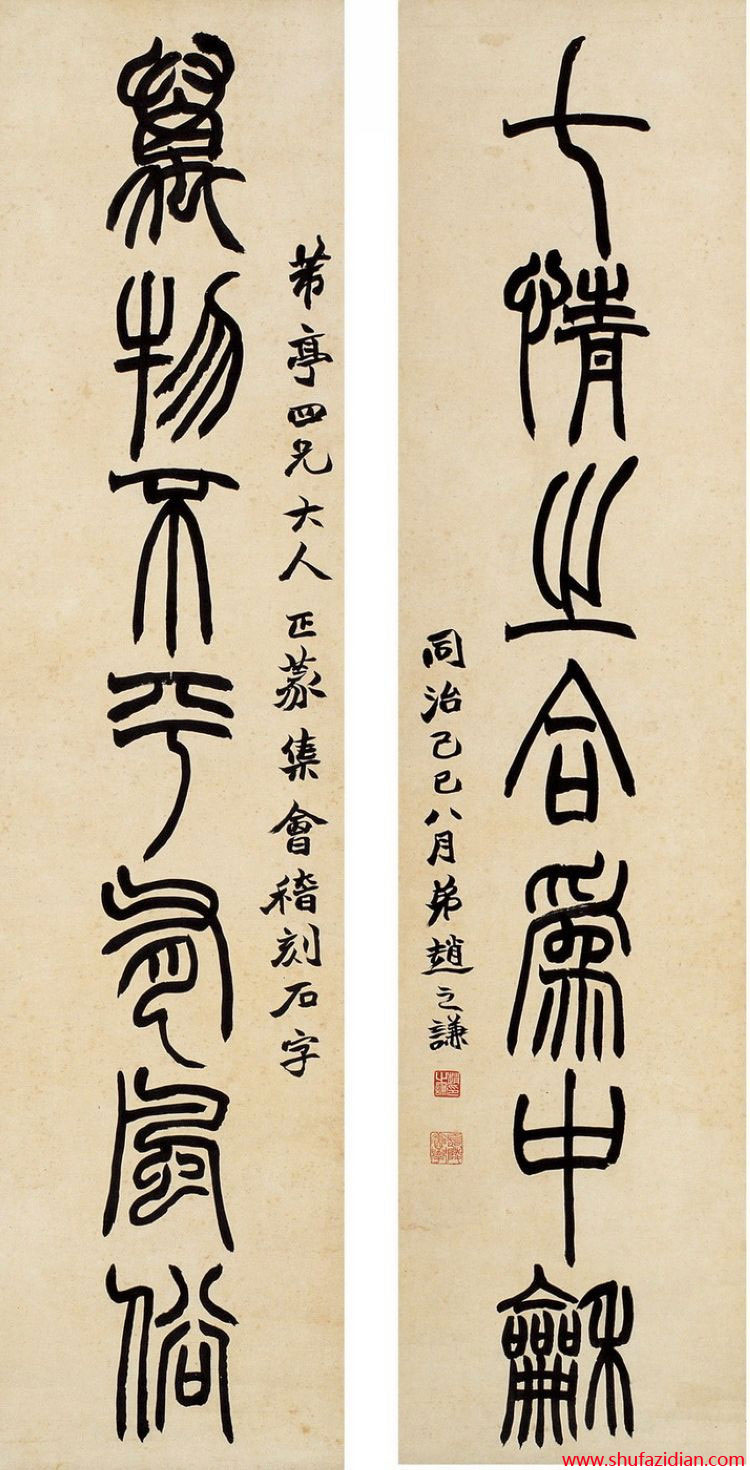
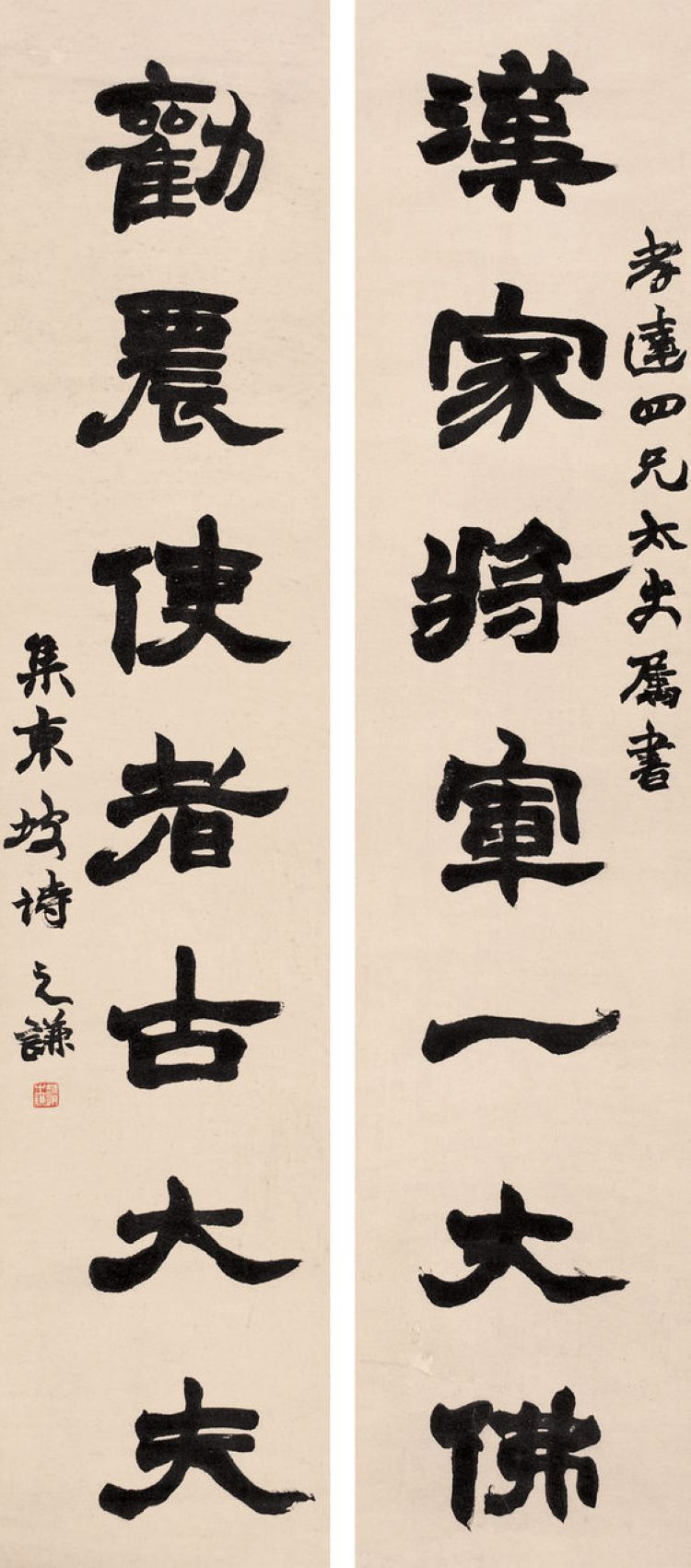
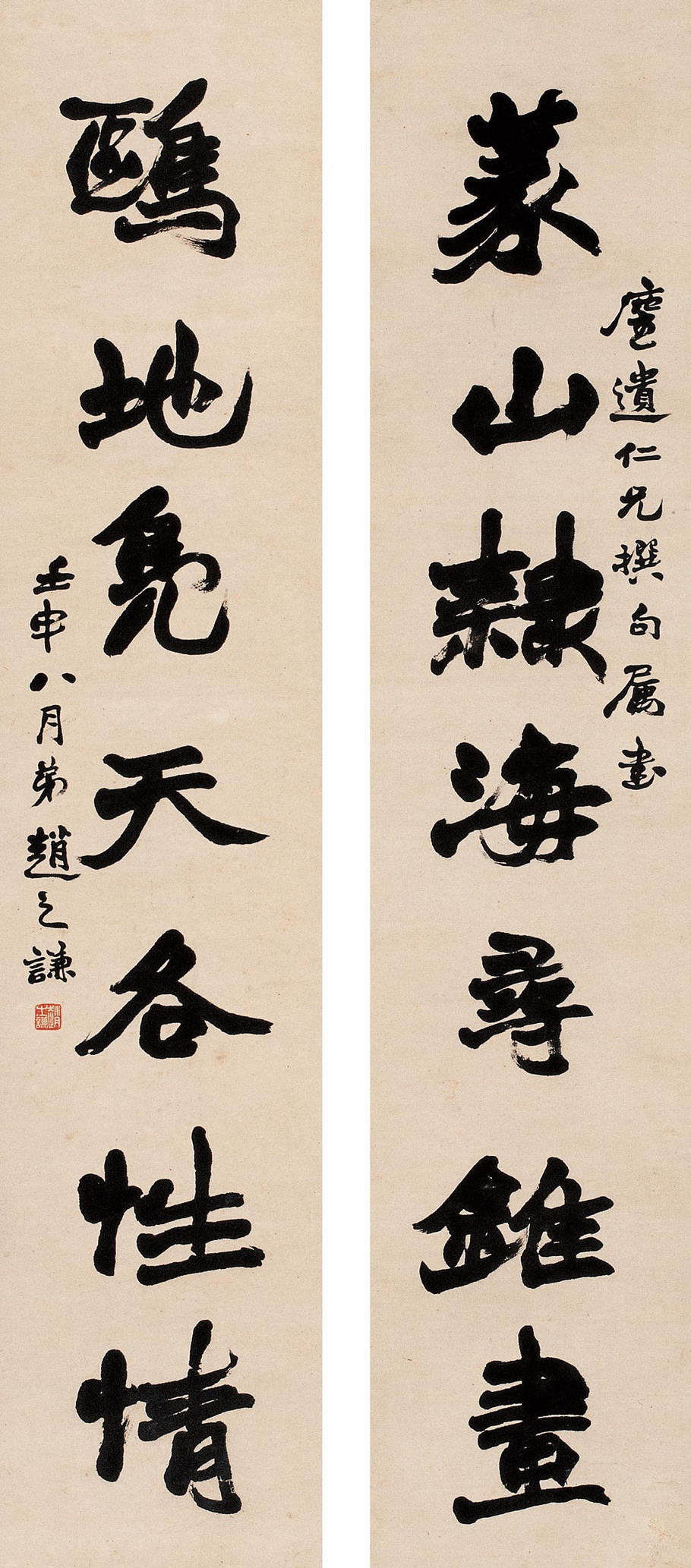
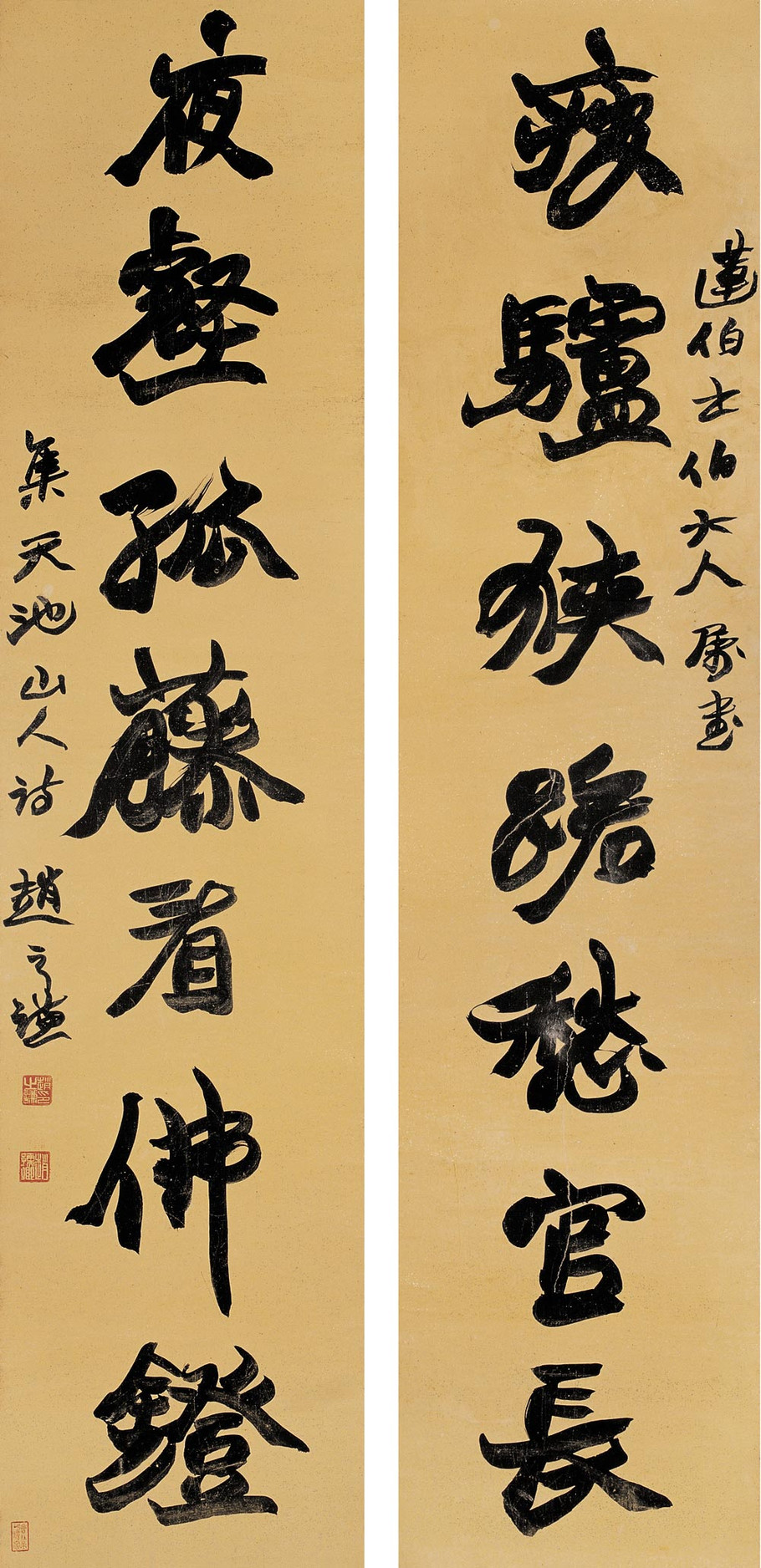
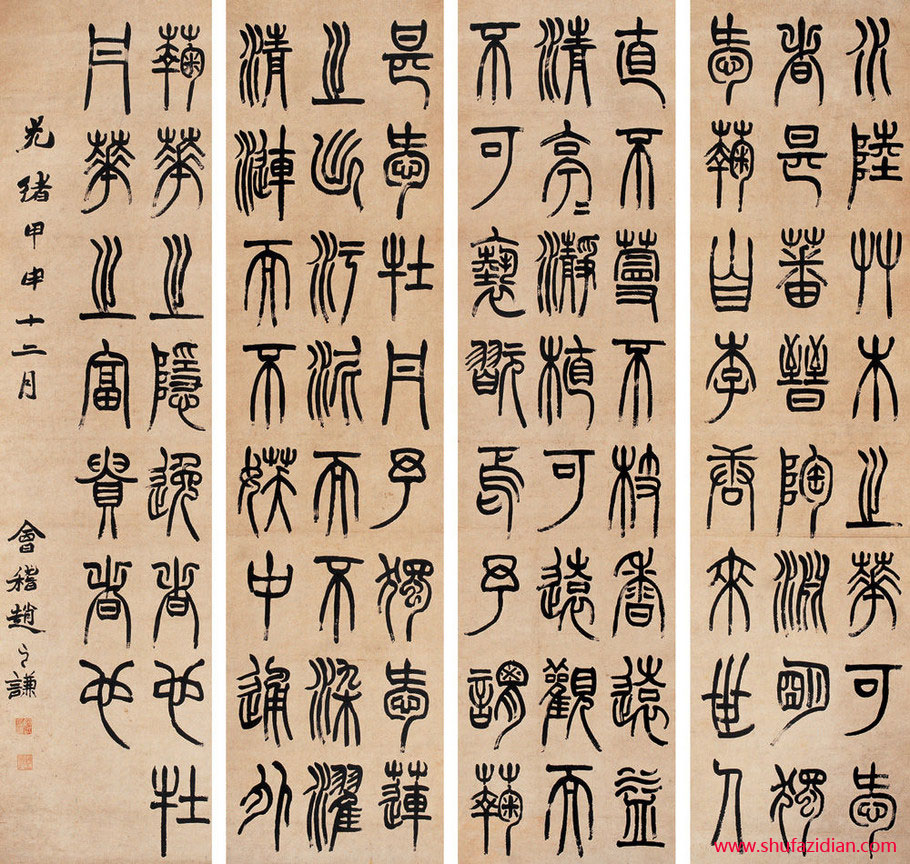
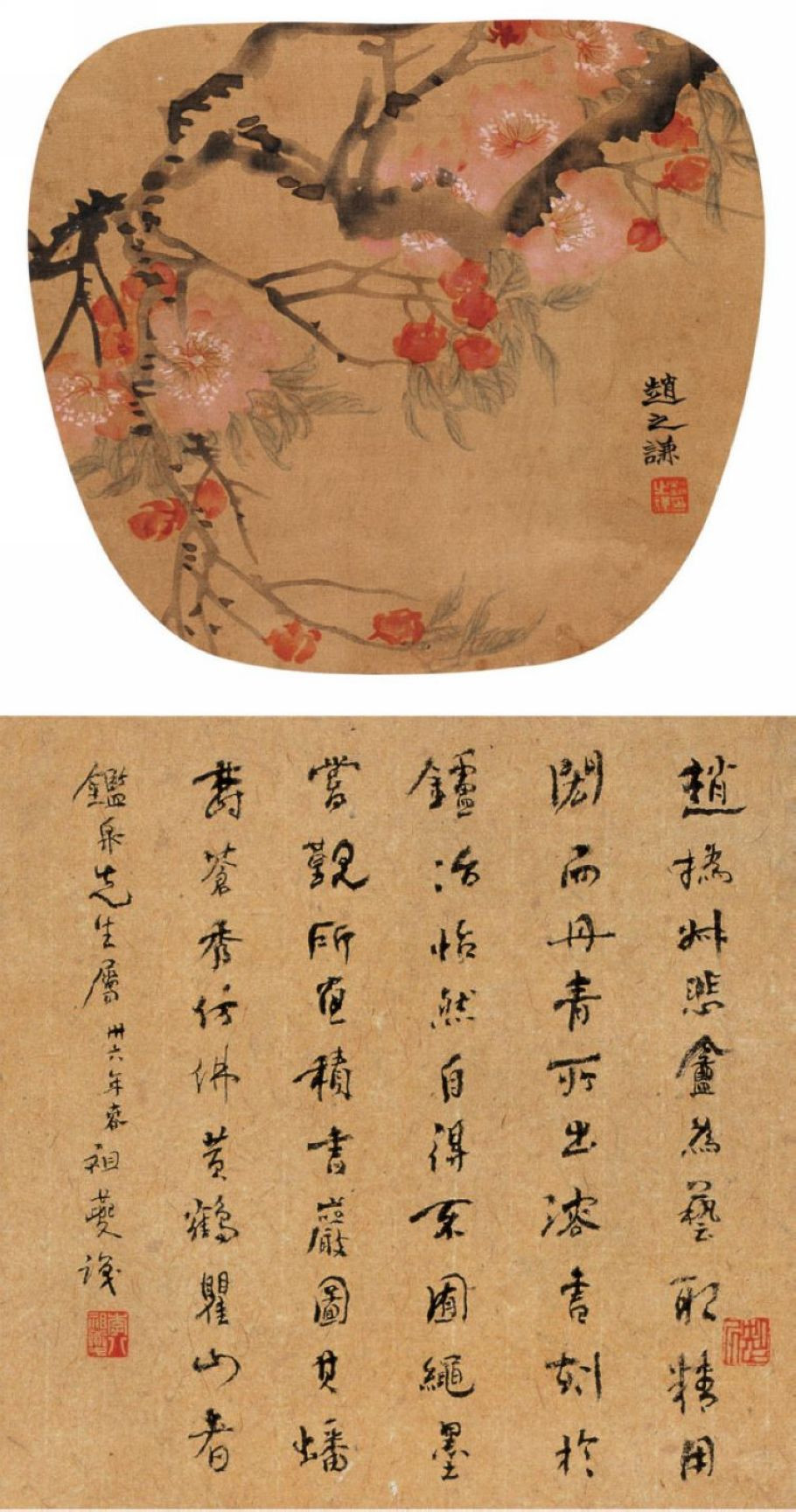

There are tens of thousands of seal scripts hanging horizontally (3.36 million yuan, Xiling, December 2009)
Notes: Jiezi asked for these three characters at eleven feet, and it was said that the text was "happy", "happy", "happy" and "joyful". In the Book of Han Dynasty, the word "joy" is mostly written as "晙". Eucalyptus "Spring and Autumn" Yuan Mingbao said: Two mouths holding the title of a scholar is joy, and the joy makes the heart clear, and the happy person is Xi, and Xi Tianxin. Song Jun's note: The heart is the palace where the king of heaven governs affairs, and all things must be prosperous, so it is joyful. There are tens of thousands of words that should be followed by Weiyi. If there is a lot of joy, it is definitely not a million joys and I will not allow it. In the eighth month of Ding Mao's reign in Tongzhi, Zhao Zhiqian knew both the book and the book.

Fude Longevity Zhai, frame, ink on paper (6.9 million yuan, published in Beijing in June 2011)
This work was published in many collections of Zhao Zhiqian's works. The calligraphy style combines hardness and softness. The font is tightly knotted at an angle, tight at the top and loose at the bottom, and the stipples are square and sharp. A soft brush is used to express the shape of the strokes carved by the knife, which fully expresses the study of stele. The unique charm of calligraphy. For the horizontal strokes of the characters "长", "Shou" and "Zhai", the tip of the pen should face the upper left when starting the pen, then cut the side of the pen into the paper, and then stroke smoothly from left to right. During the writing process, the wrist is exerted, and the pen tip and pen belly are used together to achieve a full and thick writing effect. This also makes the longer horizontal pen often slightly curved. When closing the pen, the pen is not paused, but is lifted slightly like the lower right corner, forming an oblique section similar to the one where the pen was started. The vertical strokes of the characters "福", "德", and "Zhai" are written similarly to the horizontal strokes. They start from the side and close to the lower right, and then close out to form the same oblique plane. The ends of the strokes of the characters "福", "德", and "Zhai" are usually thick and full due to heavy pressing. The horizontal hook and vertical hook of the character "Shou" are pushed out along the front, similar to the outline. The characters "长", "之", and "Zhai" make the brush strokes spread out, reflecting the writing performance of the brush. The whole work is written in thick and thick strokes, like a knife carving a stele, without losing the brushwork. It reflects Zhao Zhiqian's strong ability to control the brush strokes. He combines the strong and powerful stele characteristics with the naturally changing brushwork characteristics, creating a style of calligraphy in stele studies. new chapter.
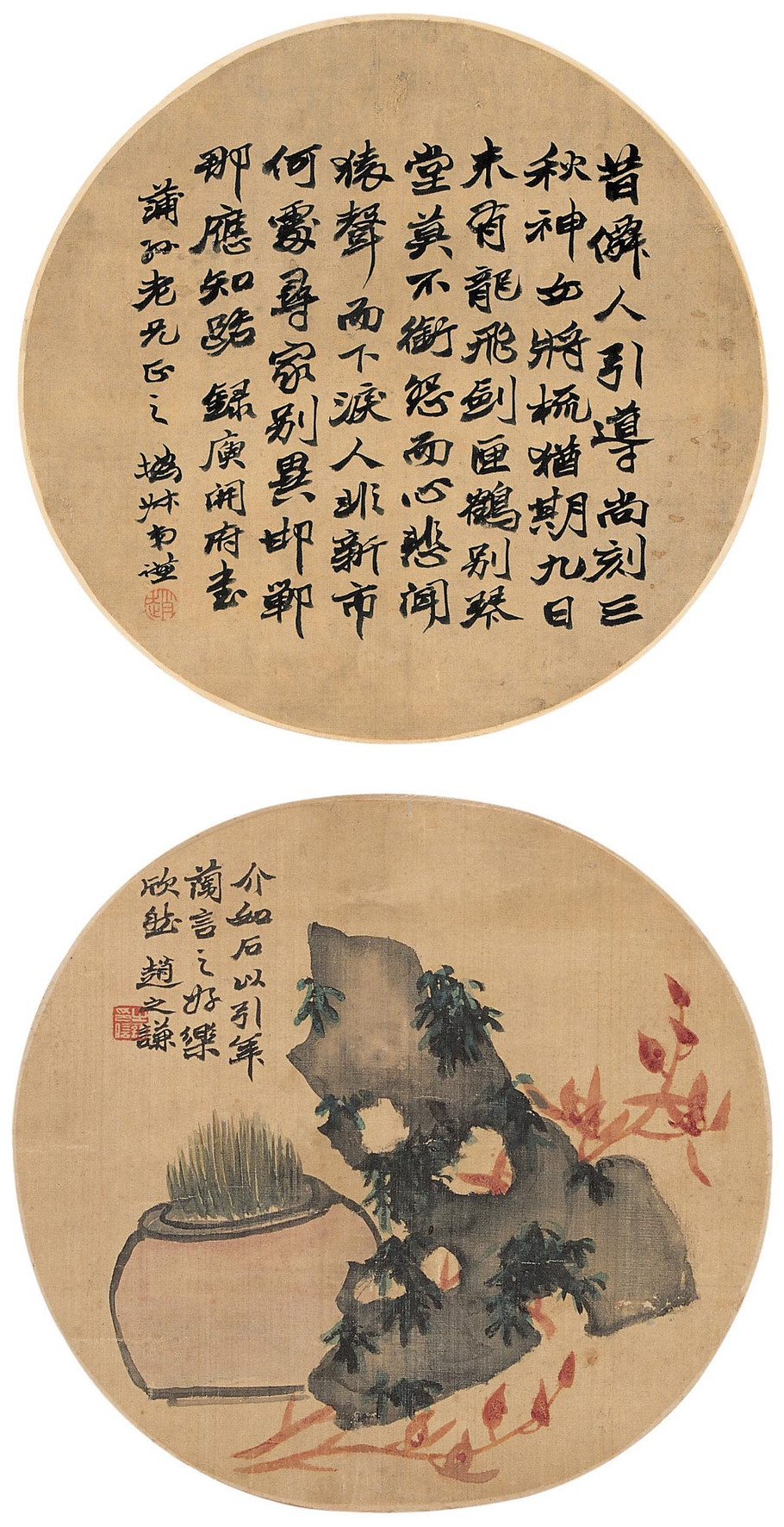
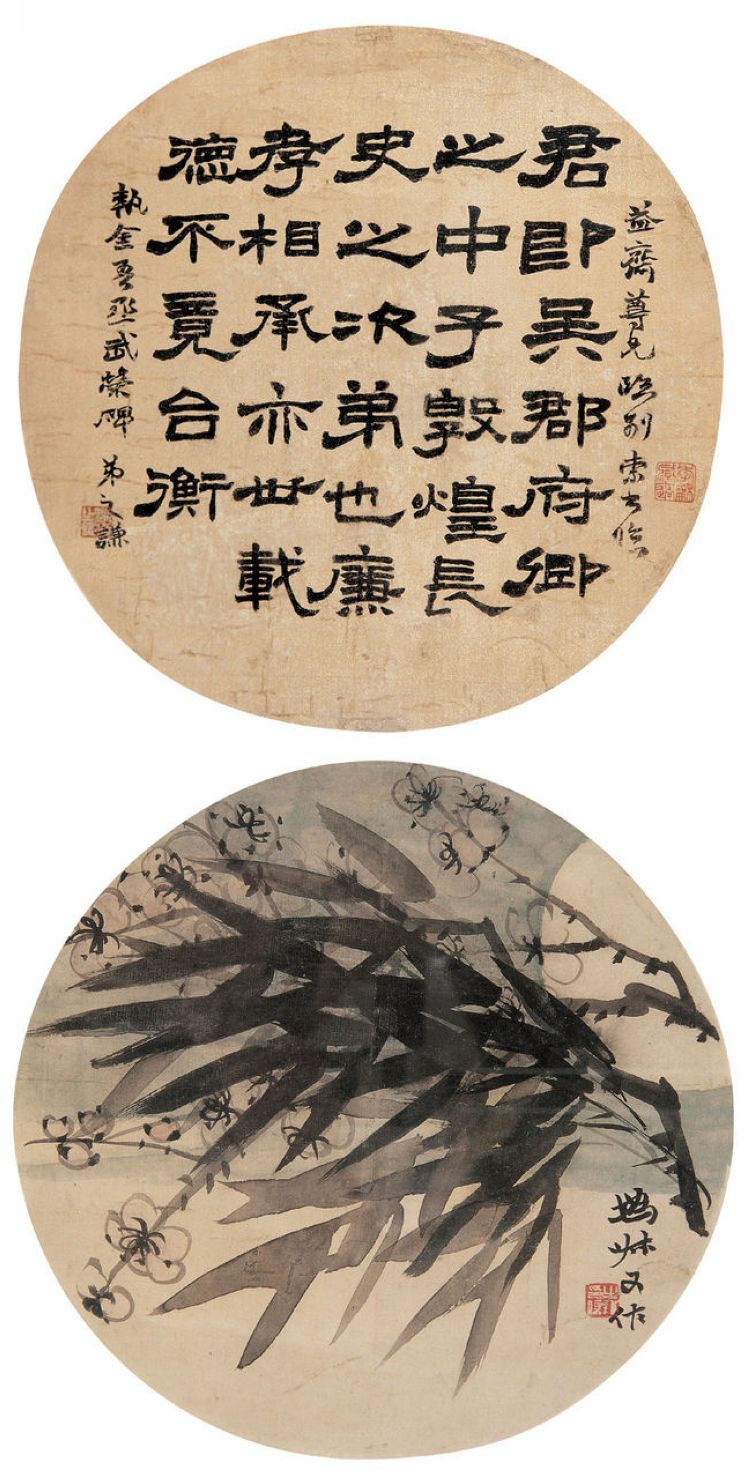
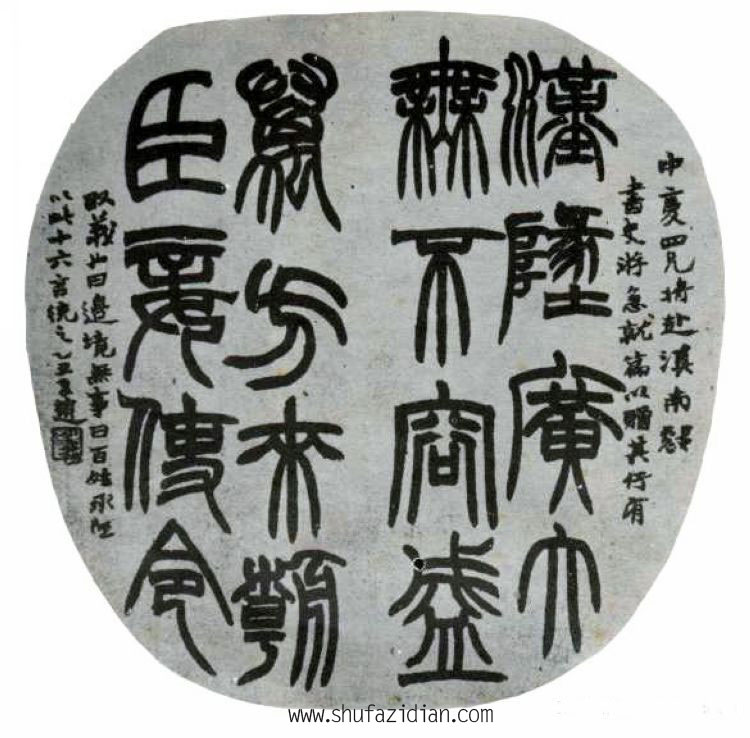
Zhao Zhiqian's "Seal Script Fan"
Zhao Zhiqian incorporated the calligraphy style of the Northern Wei Dynasty statues into the seal script. The beginning and end of the stroke are clearly made in the style of a statue. The sharp edges are subtly revealed in the lifting and pressing, and the flow of energy during this period is amazing.
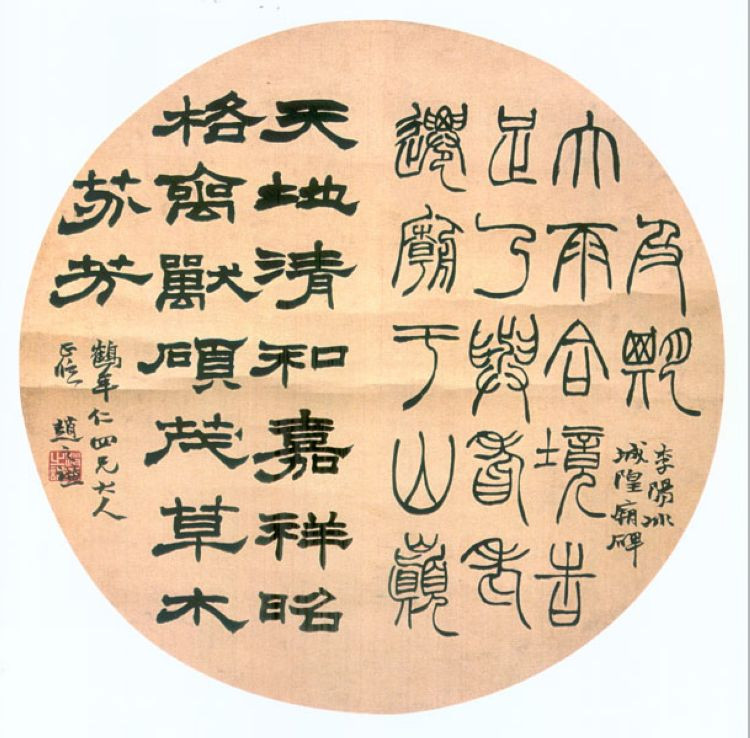
For the Year of the Crane, the seal and official two-body round fan
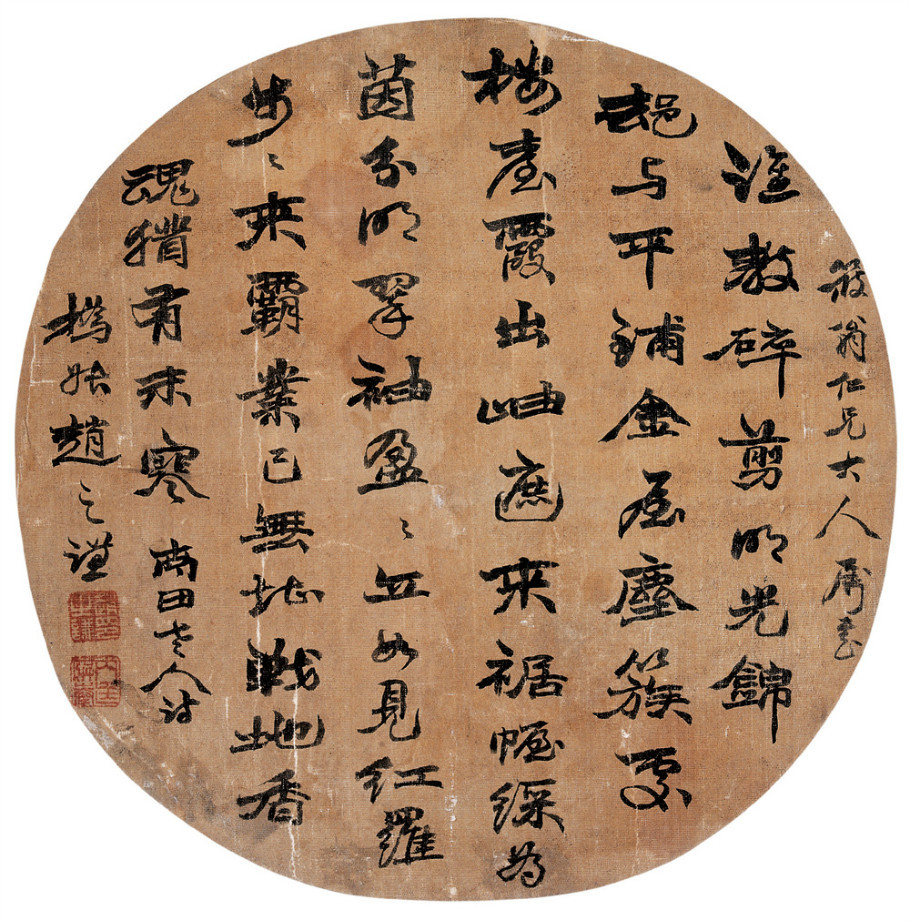
Nantian Old Man's Poems Running Script Fan Page
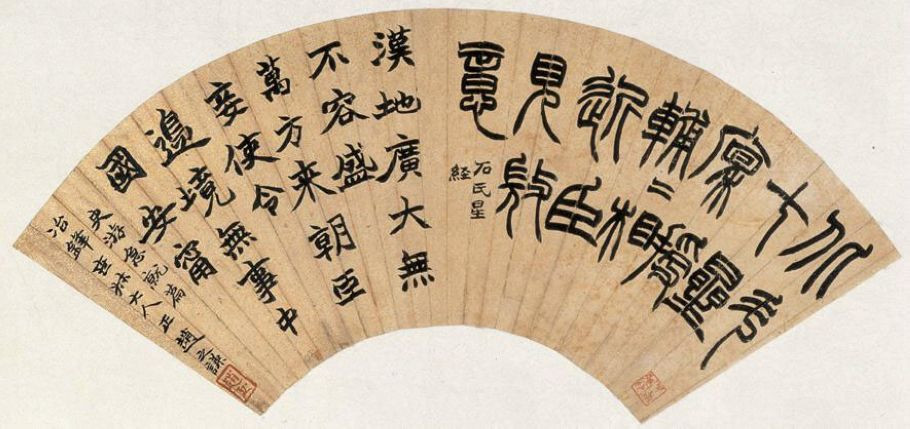
"Seal Script Fan"
